Neutron yield measurement system of HL-2A tokamak
Guoliang YUAN (袁国梁),Zuowei WEN (温左蔚),Lingfeng WEI (魏凌峰),Jinwen ZHANG (张进文) and Qingwei YANG (杨青巍)
Southwestern Institute of Physics,Chengdu 610225,People’s Republic of China
Abstract This research presents the development of HL-2A neutron yield measurement which includes 235U fission chamber and BF3 and 3He proportional counters.Equivalent noise formula of the radiation detection signal amplification system was derived to guide the development of the signal amplification system.Then all detectors were calibrated in situ by using the 252Cf neutron source.The neutron yield of the HL-2A during neutral beam heating was analyzed.These results indicate that the developed neutron flux diagnostic system can obtain neutron yield results under various experimental conditions of the HL-2A tokamak,and can provide information on neutron yield.
Keywords: HL-2A,neutron yield,neutron flux,fission chamber,in situ calibration,equivalent noise charge
1.Introduction
The ultimate goal of fusion energy research is to obtain the power output.The measurement of fusion power or neutron yield is basic requirement for large and medium tokamaks.There are two types of technologies: detector-based measurement and activation measurement [1-3].This research focuses on the detector-based neutron yield measurement of HL-2A tokamak because it can provide time-resolved results.
When tokamak operates,plasma generates a mixed radiation of hard x-rays,gamma rays and neutrons.The gas ionization detector has a strong anti-interference ability against hard x-rays and gamma rays due to its small ionization cross-section,and is a good choice for neutron detection.235U fission chamber and BF3and3He proportional counters are widely used in the neutron flux measurement.The principles of three types of detectors are as follows:
(a) fission chamber,the neutron reaction with the fissile material producing fission fragments and neutrons.The energy of fission fragments is up to 160 MeV.
(b) BF3proportional counter


(c)3He proportional counter

The high-energy particles produced by the above neutron reactions generate ionization signals in the gas ionization detector.Among three types of reactions,the fission reaction releases the largest reaction energy.Therefore,the fission chamber has the best performance on the anti-interference ability of hard x-rays and gamma rays,and is primary neutron yield detector in TFTR[4,5],JET[6],JT-60U[7],LHD[8],EAST [9,10] and ITER [11,12].BF3and3He proportional counters can be used in lower neutron yield measurement [7,9,10].
In this work,we present the development of HL-2A neutron yield measurement system which is based on a 95%enriched235U fission chamber and BF3and3He proportional counters,and in situ calibration results.Section 2 starts from the theoretical derivation of the equivalent noise,describes the development of the preamplifier and the results of detectors test,and finally introduces the arrangement of neutron detectors.Section 3 gives the in situ calibration work and the HL-2A experimental results,and followed by a summary and conclusion in section 4.
2.Development of neutron yield measurement system
2.1.Equivalent noise charge of the radiation detection signal amplification system
In previous work [13],we have developed the neutron flux detector with flat energy response and tested it on the monoenergy neutron source.However,it was found difficult to suppress the noise of the235U fission chamber during the development process.Researches [14-16] on the fission chamber did not provide detailed information in this field.It is necessary to analyze the noise of the fission chamber.Some researchers [17] deduced equivalent noise charge (ENC) for typical detector and amplifier system,however it can be seen from the derivation here that the derivation process needs further improvement.
For a typical signal amplification system,as shown in figure 1,the transfer function of amplifier is A·T(ω),in which A is gain independent frequency and T(ω)is frequency response.The noise is equivalent to the input noise source of the spectral density:

where a and Afare white and 1/f term of series source,respectively,and b and Bfare white and f term of parallel source,respectively.The white series noise is mainly due to the thermal noise affecting the drain current of the preamplifier input field effect transistor (FET).The 1/f series noise arises mainly from the 1/f component of the drain(collector) current noise of the preamplifier input transistor[18].Parallel noise arises from the detector leakage current,the first input current (base current or FET gate current) and thermal noise of detector bias resistors.The spectral densities considered here are mathematical,defined on the(-∞,+∞)frequent range.
The noise voltage at input can be written as:

where CTis total input capacitance including detector capacitance Cdand input capacitance of preamplifier Ci.Therefore,the output noise voltage can be calculated by

Substituting equations (4) and (5) into equation (6),we get:
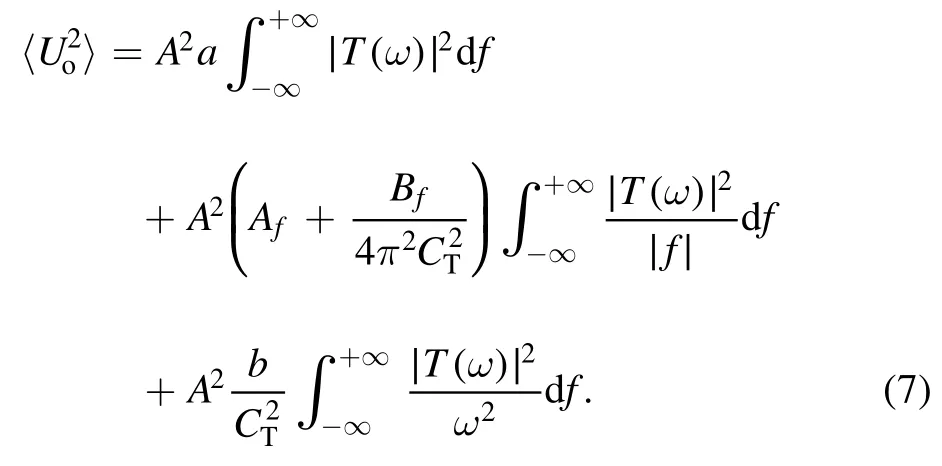
T(ω) is a function with the dimension of a frequent.The output noise voltage provided by equation(7)can be written in a more significant way in dimensionless.For a certain amplification system,τ is characteristic time-constant or the peaking time,standard deviation or full-width at half maximum,or base width.Putting x/τ for ω in the integrals of equation(7),x is dimensionless parameter,and the output noise becomes:
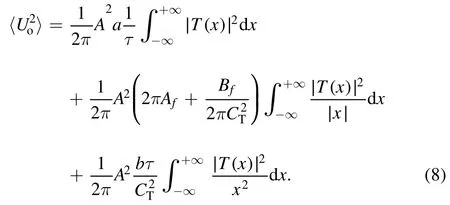
When a signal with a charge of Q is generated on the detector,the voltage at the input terminal is

The radiation detection signal amplification system amplifies the input signal.Within a certain frequency range,the amplification factor is independent of frequency.The maximum signal voltage at the output terminal can be written as follows:

where k is a constant independent of frequency.Let,solving the equivalent noise charge at the input terminal as:
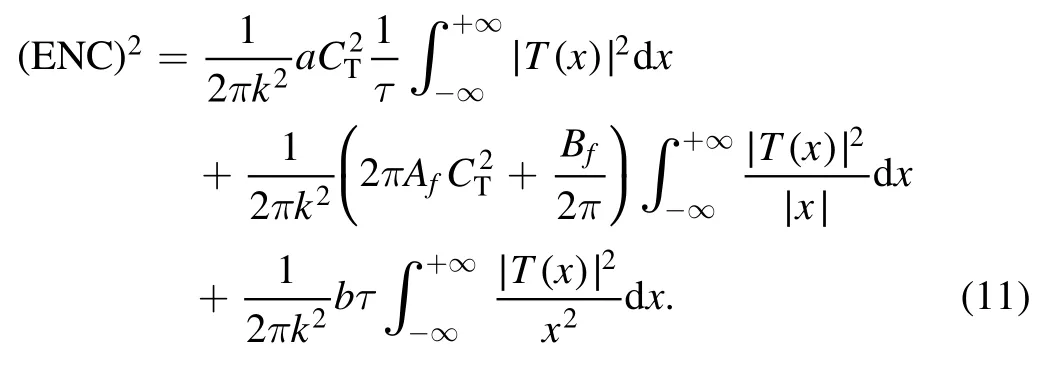
By putting:



the final form of squared equivalent noise charge becomes:

The equivalent noise charge is therefore represented through the total capacitance CT,the noise parameter a,b,and Af,the time-constant τ and three shape factors A1,A2,and A3of the amplification system.Table 1 provides calculated values of shape factors in various amplification systems including the widely-used CRn-RCnsystem.

Table 1.Shape factors in various amplification systems.

Table 2.Positions and parameters of HL-2A neutron yield detectors.

Table 3.Detection efficiency of HL-2A neutron yield detectors.
2.2.Design of preamplifier in fission chamber
The fission chamber is a type of gas ionization chamber which is based on collection of the charges created by direct ionization within the gas.Its electrode is coated with fissile materials.Fissile materials are radioactive and mainly emit alpha particles with MeV energy,which causes additional parallel noise.In order to reduce the impact of parallel noise,time-constant τ of signal amplification system should be small according to equation(13).The small τ is also benefit to increase the counting rate.
The detector capacitance Cdof fission chamber is very large.Then it can be concluded from equation (13) that the ENC mainly comes from the series white noise.It is necessary to decrease the white series noise figure which is mainly due to the channel resistance noise of FET.With reference to the results of other researchers [19,20],the FET with low white series noise figure is used as the input stage,and the commercial operational amplifier is used as the amplifying stage and output stage,thus a compact charge preamplifier has been developed [21].
Then the preamplifier and the235U fission chamber detector were tested together.In the test,a 5-meter RG-59 cable,which is low capacitance(52 pf/m),is used to connect the detector and the preamplifier.The total input capacitance reached 810 pF.The output of the preamplifier is shaped by a specially designed CR-RC amplifier and sent to a multichannel analyzer (Canberra Multiport II) in order to observe the pulse height spectrum.The noise amplitude spectrum is obtained when no bias voltage is applied to the235U fission chamber.When the235U fission chamber is biased by high voltage,the alpha signal amplitude spectrum is obtained.The acquisition time of the noise spectrum and the alpha signal amplitude spectrum is one minute.The neutron signal amplitude spectrum was obtained by placing the235U fission chamber in a252Cfneutron source for 72 h.The amplitude spectra of noise,α and neutron signals obtained at different time-constant are shown in figure 2 [21].The value of the pulse height is obtained by converting the charge into energy by the argon ionization energy (26.4 eV).The three timeconstants of the upper,middle and lower graphs are respectively 0.1 μs,1 μs and 10 μs.From these amplitude spectrums,it can be found that when the time-constant is 1 μs,the noise is the lowest.It is because that the 10 μs time-constant case increases the parallel noise contribution,and 0.1 μs timeconstant case increases the series noise contribution.Figure 2 also shows that alpha signal is the lowest in the 0.1 μs timeconstant case.It is considered that the short time-constant decreases the probability of alpha signal accumulation.In the HL-2A experiment,the time-constant of235U fission chamber system is set to 0.1 μs.
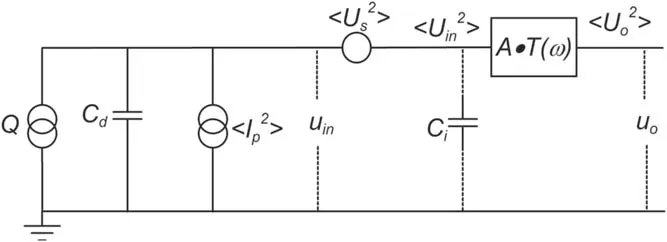
Figure 1.Noise equivalent circuit of a signal amplification system.
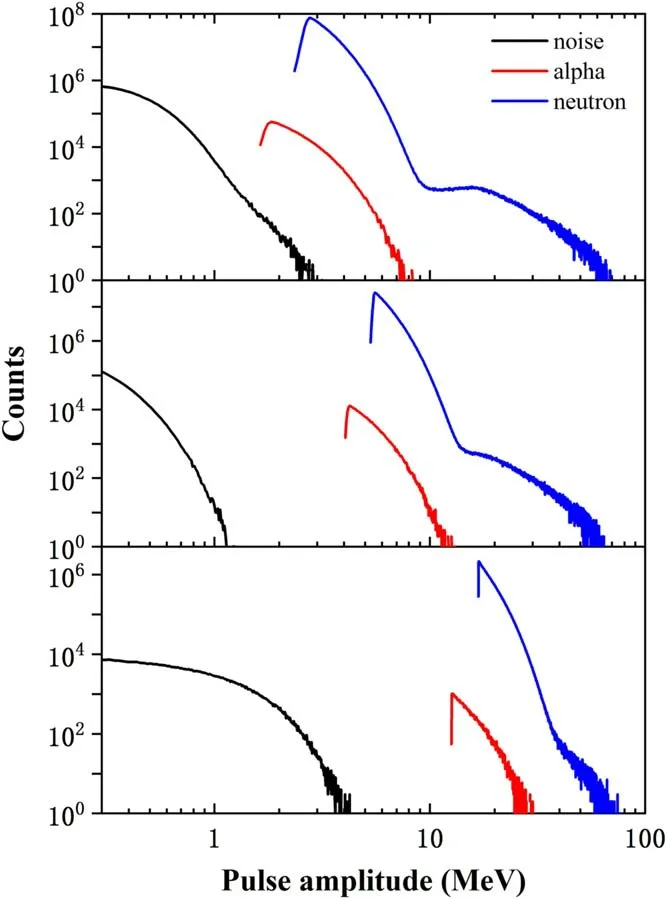
Figure 2.Pulse amplitude spectrum of noise,alpha and neutron,time-constant: top,0.1 μs; middle,1 μs,bottom,10 μs.Reprinted from [21],Copyright (2020),with permission from Elsevier.
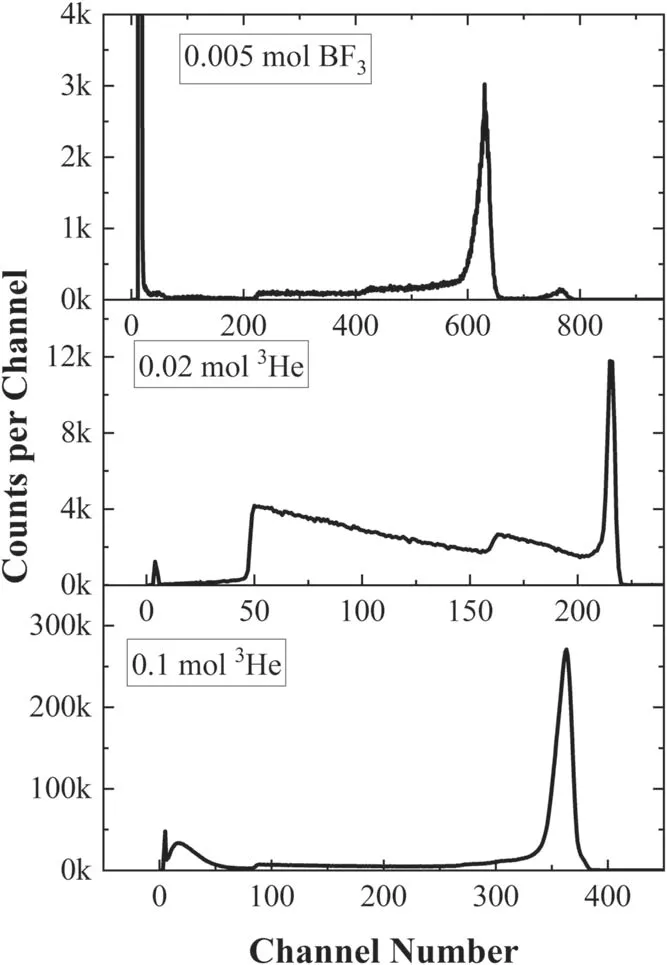
Figure 3.Pulse amplitude spectrum of BF3 and 3He proportional counters.
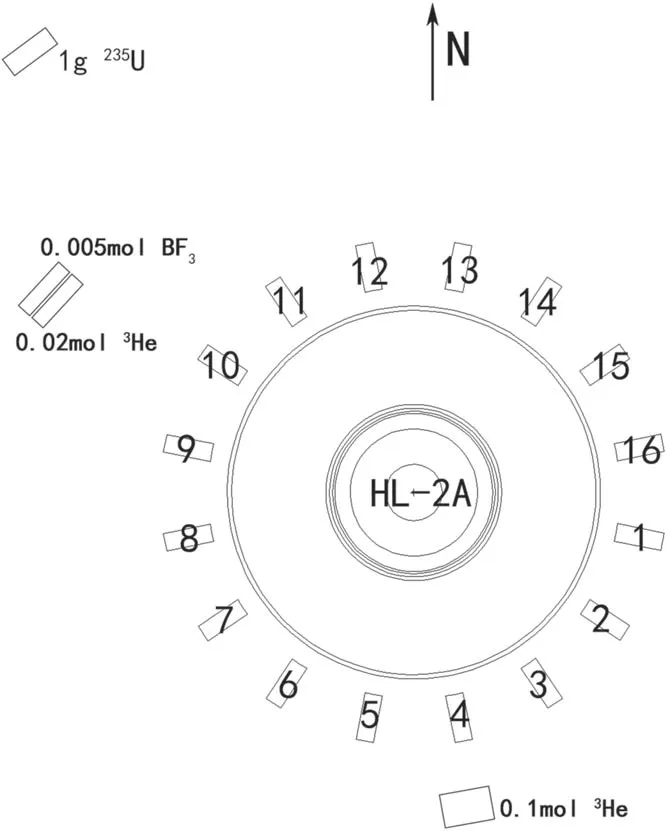
Figure 4.Schematic diagram of HL-2A neutron yield detectors arrangement.

Figure 5.Detection efficiency as a function of toroidal angle between detectors and neutron source.
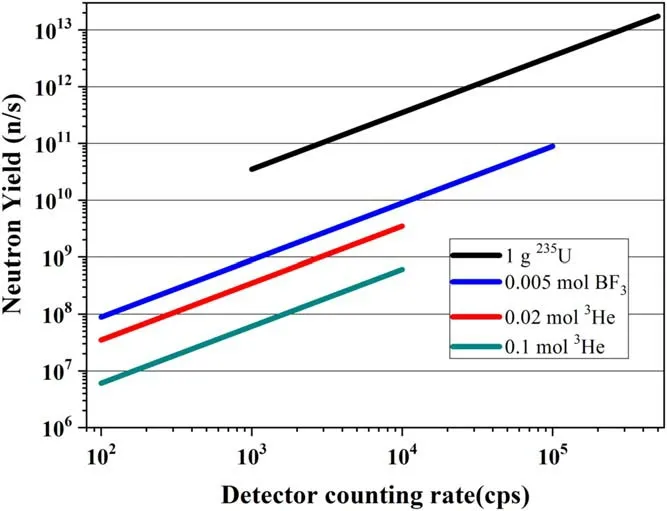
Figure 6.Measurement range of HL-2A four neutron detectors.

Figure 7.Measurement results of the neutron yield of HL-2A 37012 experiment.
2.3.Proportional counter
Proportional counter is a type of gas ionization detector which relies on the phenomenon of gas multiplication to amplify the charge produced by the primary ion pairs within the gas.Therefore,pulses are larger than those from ionization chambers under the same conditions,and the effect of noises is slightly.
Compared with the3He proportional counter,the BF3proportional counter has a larger reaction energy,so it has a better performance in anti-interference ability against hard x-rays and gamma rays.In addition,the3He proportional counter can obtain greater sensitivity and can be used for lower neutron flux measurements.Three proportionalcounters with different sensitivities are installed on the HL-2A,and their parameters are shown in table 2.
The capacitance of the proportional counter is small due to and its very thin anode.Therefore,series noise is not serious.The signal amplification of the proportional counter is simple.It should be noted that the time-constant of the signal amplification system cannot be too small to avoid ballistic loss.
Three proportional counters were tested in a polyethylene moderator housing irradiated by a neutron source.The same preamplifier,amplifier and MCA as in the above test were used.The pulse amplitude spectrum is shown in figure 3.The top one is BF3counter,and shows two branch reactions.The middle one is3He counter.The full energy peak and the socalled wall effect can be clearly seen.The bottom one is3He counter,and its wall effect is very slight due to its large radius and high gas pressure.
2.4.Arrangement of neutron yield detector
All detectors are placed inside polyethylene moderator housings to achieve flat energy response [13].In order to increase the measurement range,the most sensitive detector is placed at the position closest to the HL-2A tokamak,and the least sensitive detector is placed at the farthest position fromthe HL-2A tokamak,as shown in figure 4.All detectors are placed at the mid-plane of HL-2A tokamak.1 g235U represents the235U fission chamber which is arranged between the toroidal field coils (TFC) 10 and 11; the 0.005 mol BF3and 0.02 mol3He proportional counters are arranged between TFC 9 and 10; the 0.1 mol3He proportional counter is arranged near to TFC 4.
3.In situ calibration and HL-2A experimental results
The absolute detection efficiency of the neutron flux monitor needs to be calibrated so that the output of the detector can provide the information of the neutron yield,or the fusion power.Large devices such as JET [1,6],JT-60U [7],TFTR[4,5,22] and LHD [23] have carried out in situ neutron calibration,and obtained good experimental results.
In the spring of 2021,the detection efficiency of the neutron flux detectors was calibrated using a252Cfneutron source with an intensity of 2.2×107neutrons per second.The252Cfneutron source is always located at magnetic axis.With reference to the support plate in the vacuum vessel,16 homogeneous points are calibrated in the toroidal direction.The amplifier outputs of four detectors are recorded and processed online by Keysight M3100 digitizer (FPGA programmable,14 Bits,100 MSa/s).
The detection efficiency varies with toroidal angle between detectors and neutron source,as shown in figure 5.When the detector and the neutron source are at the same toroidal angle,the detection efficiency is high,and it decreases as the toroidal angle increases.The ratio of maximum efficiency to minimum one for a detector is in the range of 10-100.It is shown that the detection of neutrons is localized.In order to obtain reliable neutron yield results,it is necessary to arrange multiple detectors in the toroidal direction.The detector efficiency is calculated directly by averaging the efficiency of each detector,as shown in table 3.
The charge collection time of the235U fission chamber,3He and BF3proportional counters are different,and the measured values are 0.1 μs,2 μs and 0.2 μs,respectively.Therefore,it can be assumed that the maximum counting rates in the counting mode are 500,10 and 100 kHz.The calculated measurement range of the four detectors is shown in figure 6.It can be seen that the four detectors can cover a total neutron yield range of approximately 7 orders of magnitude from 6×106to 2×1013n s-1.
We revisited the results of HL-2A 37012 experiments in 2019.As shown in figure 7,the plasma current is about 180 kA,the average electron density of the center chord is (2-2.5)×1019m-3,the neutral beam heating power is 1.4-1.5 MW,and the maximum neutron yield measured by235U fission chamber is 7×1012n s-1.
4.Conclusions
This work presents the neutron yield measurement system of HL-2A tokamak which is based on the gas ionization detectors,including235U fission chamber for high neutron yield measurement and BF3and3He proportional counters for low neutron yield measurement.All detectors were in situ calibrated using252Cfneutron source.The HL-2A experiment in 2019 was analyzed based on the calibration results.When HL-2A is heated by the 1.5 MW neutral beam injection,the maximum neutron yield reaches to 7×1012n s-1.
Since the detection of the neutron flux detector is localized,further work is to develop multiple fission chamber neutron detectors symmetrically distributed in the toroidal direction,and proportional counter detector will be used to study the HL-2A Ohmic heating experiment.
Acknowledgments
This work was partially supported by the Science & Technology Department of Sichuan Province in China (No.2021YFSY0018),National Natural Science Foundation of China (No.11675049).
The authors would like to thank Dr.Luan Chunhong for the English language review.
 Plasma Science and Technology2022年6期
Plasma Science and Technology2022年6期
- Plasma Science and Technology的其它文章
- Recent progress on the J-TEXT three-wave polarimeter-interferometer
- Design of the stripping unit and the electromagnetic analysis unit for the E//B NPA on HL-2A/2M tokamak
- Space-resolved vacuum-ultraviolet spectroscopy for measuring impurity emission from divertor region of EAST tokamak
- Development of a combined interferometer using millimeter wave solid state source and a far infrared laser on ENN’s XuanLong-50(EXL-50)
- Bench test of interferometer measurement for the Keda Reconnection eXperiment device (KRX)
- Study of the fast electron behavior in electron cyclotron current driven plasma on J-TEXT
